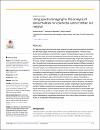Using spectral imaging for the analysis of abnormalities for colorectal cancer: When is it helpful?
| Author | Awan, R. |
| Author | Awan, Ruqayya |
| Author | Al-Maadeed, Somaya |
| Author | Al-Saady, Rafif |
| Available date | 2019-09-18T11:20:01Z |
| Publication Date | 2018-06-01 |
| Publication Name | PLoS ONE |
| Identifier | http://dx.doi.org/10.1371/journal.pone.0197431 |
| Citation | Awan R, Al-Maadeed S, Al-Saady R (2018) Using spectral imaging for the analysis of abnormalities for colorectal cancer: When is it helpful? PLoS ONE 13(6): e0197431. https://doi.org/10.1371/journal.pone.0197431 |
| Abstract | © 2018 Awan et al. This is an open access article distributed under the terms of the Creative Commons Attribution License, which permits unrestricted use, distribution, and reproduction in any medium, provided the original author and source are credited. The spectral imaging technique has been shown to provide more discriminative information than the RGB images and has been proposed for a range of problems. There are many studies demonstrating its potential for the analysis of histopathology images for abnormality detection but there have been discrepancies among previous studies as well. Many multispectral based methods have been proposed for histopathology images but the significance of the use of whole multispectral cube versus a subset of bands or a single band is still arguable. We performed comprehensive analysis using individual bands and different subsets of bands to determine the effectiveness of spectral information for determining the anomaly in colorectal images. Our multispectral colorectal dataset consists of four classes, each represented by infra-red spectrum bands in addition to the visual spectrum bands. We performed our analysis of spectral imaging by stratifying the abnormalities using both spatial and spectral information. For our experiments, we used a combination of texture descriptors with an ensemble classification approach that performed best on our dataset. We applied our method to another dataset and got comparable results with those obtained using the state-of-the-art method and convolutional neural network based method. Moreover, we explored the relationship of the number of bands with the problem complexity and found that higher number of bands is required for a complex task to achieve improved performance. Our results demonstrate a synergy between infra-red and visual spectrum by improving the classification accuracy (by 6%) on incorporating the infra-red representation. We also highlight the importance of how the dataset should be divided into training and testing set for evaluating the histopathology image-based approaches, which has not been considered in previous studies on multispectral histopathology images. |
| Sponsor | This publication was made possible using a grant from the Qatar National Research Fund through National Priority Research Program (NPRP) No. 6-249-1-053. The content of this publication are solely the responsibility of the authors and do not necessarily represent the official views of the Qatar National Research Fund or Qatar University. |
| Language | en |
| Publisher | Public Library of Science |
| Subject | Algorithms Biopsy Colorectal Neoplasms Diagnostic Imaging Humans Neural Networks (Computer) Light |
| Type | Article |
| Issue Number | 6 |
| Volume Number | 13 |
| ESSN | 1932-6203 |
Files in this item
This item appears in the following Collection(s)
-
Computer Science & Engineering [2429 items ]


